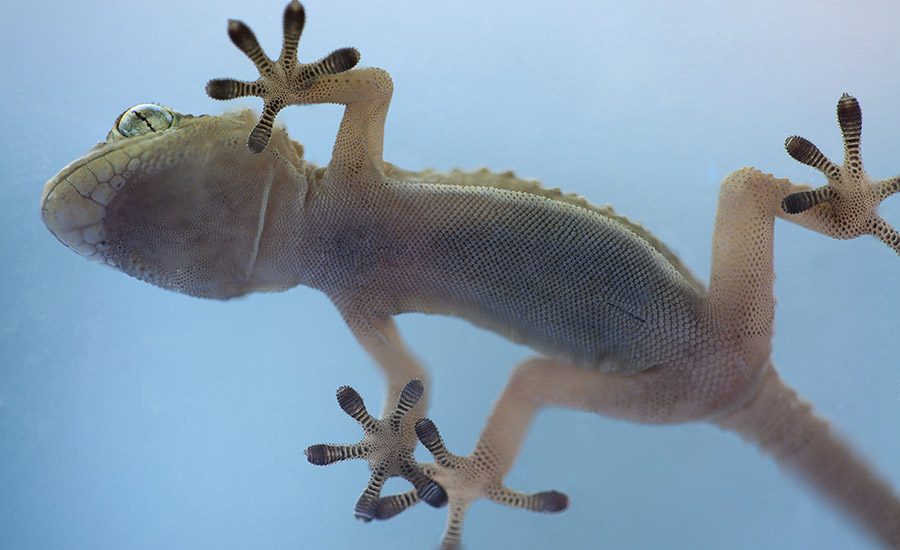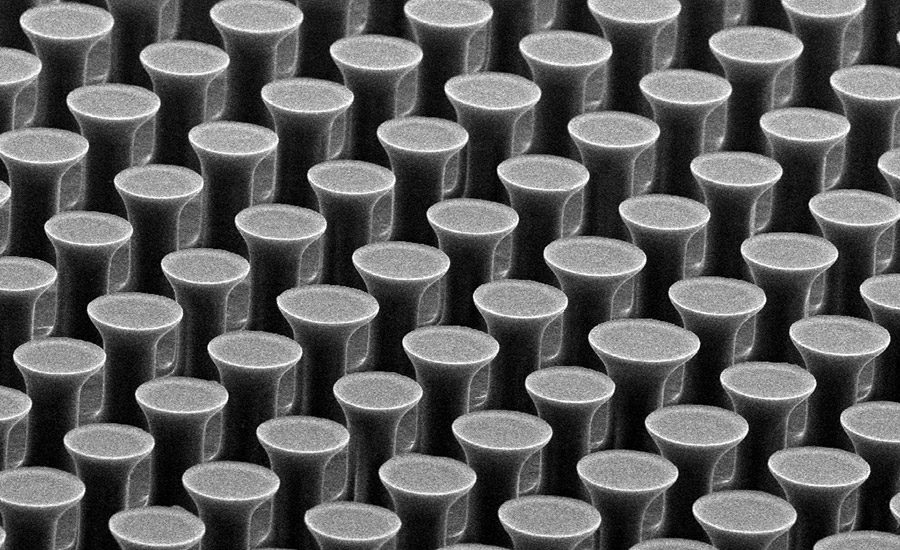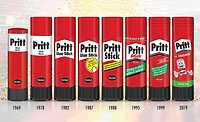Focus On
Sticking with Science
A new company spun off from the research labs of Carnegie Mellon University is commercializing gecko-inspired dry adhesives.

The gecko’s impressive climbing ability arises from the millions of nano-scale hairs that cover their foot pads.

Figure 1. Magnified view of nanoGriptech’s Setex that is composed of gecko-inspired microfibers that provide dry, repeatable adhesion.


Scientists and engineers have long used biomimicry as a way to find solutions to today’s problems in nature. For example, studying shark skin has led to new materials that bacteria cannot attach to, birds and bats have inspired aircraft design, and investigating plant leaves has resulted in light absorption efficiency innovations in solar panels.
To understand adhesion, scientists have been looking at the biological attachment strategies of the gecko lizard for inspiration. The lizard’s remarkable ability to climb up walls and run across ceilings without the use of any sticky substance or secretion has inspired researchers to develop reusable dry adhesive microfiber materials. The gecko’s approach to adhesion involves nanohairs that cover the animal’s foot pads.
The gecko’s impressive climbing ability arises from the millions of nano-scale hairs, called setae, which cover their foot pads. Setae are not composed of any special sticky substance; they are mostly composed of rigid beta-keratin, similar to the keratin protein that forms human hair and fingernails. The setae have the ability to adhere because of their size and shape. The setae branch out in a multi-level hierarchy with a 100-nm diameter, spatula-shaped tip at the terminal end that lies flat, increasing the contact surface area. When a gecko sets its foot pads against a surface, the tips come into such close contact with the surface that an intermolecular attractive force occurs. This force is small in magnitude (about 10 nN), but the cumulative force from all the setae combined gives the lizard the ability to walk up and across almost any surface. If a Tokay gecko had all of its setae in contact with a vertical wall, it would have enough adhesion force to hold up the weight of an average adult male.
nanoGriptech Inc., which emerged from the research labs of Carnegie Mellon University in Pittsburgh, has begun to commercialize gecko-inspired adhesives. Setex® is a class of adhesives that can be made in sheets or rolls. Setex was designed to mimic the design and properties of the setae―it consist of arrays of nano/micro-fibers that can conform to surfaces. The fibers’ tips are flat to achieve maximum surface contact, and the material can be removed through an easy peel-off and then reused without any degradation in performance—just as the gecko is able to walk around by peeling back their toes to release and then re-adhere.
While the gecko has one evolutionarily optimized type of fiber, nanoGriptech can make an extensive variety of fiber shapes and dimensions. Small changes in the geometry, including the stalk diameter and the tip shape, result in different adhesive and frictional properties for the Setex materials. This allows for a large database of stalk and tip shapes to enable fine-tuning of adhesive properties, even supporting directional adhesion and the ability to independently tune shear and peel strength.
New Possibilities
While this technology has been explored in research labs for over a decade, high production costs previously prevented the commercialization of gecko-inspired products. nanoGriptech has been able to take meticulously made microfibers, replicate them, and produce mass quantities through inexpensive, automated processes.
With manufacturing fine-tuned into processes that can be scaled to meet forthcoming demand, nanoGriptech has begun exploring the vast array of potential uses for the material. While the applications for the material are extensive—from car interiors to biohazard suits to glass manufacturing—the material has the potential to be disruptive in many markets. Current applications can be categorized into adhesive applications, fastening applications, and high-friction applications.
nanoGriptech’s dry adhesive products, Setex-DA, are the most analogous to the gecko’s abilities. This non-tacky material acts like an adhesive tape when applied to surfaces. When the microfiber flat tips come into contact with a smooth, flat surface, the material will adhere with a high shear strength, yet it is residue-free and repeatable. In lab conditions, the material showed little performance degradation even after cycles of re-use into the thousands. The dry adhesive is finding its market for consumers and manufacturers in many parts fixtures, handling, transfer, and transportation applications.
Glass production is one of the first markets where nanoGriptech has begun exploring the manufacturing applications of gecko-inspired adhesives. Because of its perfectly smooth surface, glass is a textbook substrate for Setex to adhere well to. Today’s specialty coatings on glass products, such as on lenses, have posed challenges for the traditional materials that are used for fixing parts. Glass manufacturers are evaluating different uses for Setex in their manufacturing lines. The material can securely hold onto the glass workpiece during processing and transportation, with easy removal that leaves no residue and does not damage the delicate glass. The Setex can then be reused for the next workpiece; if it becomes dirty, it can be easily washed.
The fastening products, Setex-CF, use the same microstructures in combination with an optimized mating surface to create a low-profile and flexible closure system. As opposed to bulky hook and loop closures, Setex can conform to curvatures, enabling new upholstery designs. Automakers can use the material to produce new seating configurations. Seat upholstery is removable, so repairs can be performed or the seat cover replaced. Designs today are limited by traditional repeatable fasteners due to challenges with seating covers conforming to the concavities that an ergonomically designed seat contains. By fastening the upholstery to the foam seat pad with Setex, these concave seating designs are possible. The flexible Setex closure is able to sleekly conform to the curvatures along the seat.
Apparel Applications
nanoGriptech’s fasteners can also be hermetically sealed. The U.S. Army is investigating incorporating the material into biohazard suits to eliminate the breach of toxins that can occur at the site of traditional clothing closures. In preliminary studies, Setex has been shown to be more than 1,000 times more hermetic than a hook-and-loop closure. In addition, it is magnitudes more silent to open a feature of the fasteners also of interest to the Army.
nanoGriptech’s high friction and gripping material, Setex-XG, provides high friction on a variety of surfaces. The material has great friction performance on dry surfaces, but it is especially superior to other non-tacky grip alternatives on wet and oily surfaces, including skin. The microfiber tips provide enhanced friction, and the gaps of space present in the fiber array function to wick away water and oil from the surface, improving the coefficient of friction even in these difficult conditions.
Struck Apparel, a manufacturer of equestrian breeches, turned to nanoGriptech to help riders better grip the saddle by developing a high friction knee patch for their pants. One challenge that rendered traditional non-slip materials inferior was that the saddles are oiled to maintain the integrity of the leather. For the riders, being able to remain firmly seated on an oiled saddle while the horse is leaping though the air yet being able to release the grip at a moment’s notice is a big performance advantage. These days, Setex is being evaluated for use in many sporting applications where the material is proving to give athletes an edge.
When a customer is looking for a high friction material surface on a mass-produced molded part, nanoGriptech’s microfibers can be produced directly using conventional single-shot molding processes. A mold surface insert designed by the engineers at nanoGriptech can be integrated into the customer’s tool such that when a resin is shot into the tool, the resulting part has both the customer’s desired geometry as well as gecko-inspired high friction microfibers on the target part surface, directly integrated and made out of the same material. The high-friction microstructures can be formed from a variety of materials, enabling customers to use their own proprietary or preferred castable elastomer that already meets any environmental and application-specific requirements.
Medical Solutions
For medical devices and sports equipment, nanoGriptech’s Setex-XG materials can be produced using these in-mold surface treatments to increase the grip of the device with skin. These materials not only demonstrate increased friction, especially in wet and oily conditions, but also result in a surface that is almost velvet-like to the touch. Without any additional manufacturing steps, the product’s surface is transformed.
Many other potential uses and applications are possible. nanoGriptech is currently scaling up manufacturing for numerous applications, while continually investigating prospective adhesive and gripping challenges. The research in this field is ongoing, and scientists are continually studying the gecko for further inspiration on adhesive problems that still need to be solved. Materials that are resistant to contamination, can self-clean, and even those that have the ability to securely attach to skin are currently being investigated.
For more information, visit www.nanogriptech.com.
Looking for a reprint of this article?
From high-res PDFs to custom plaques, order your copy today!







